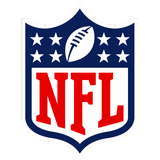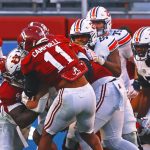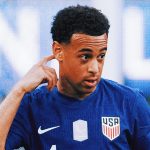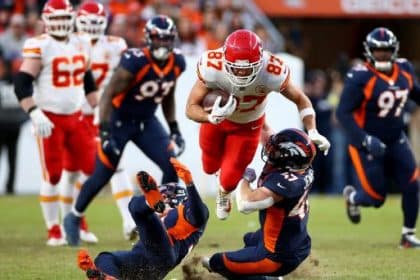The NFL Draft contains multitudes. It runs the emotional gamut. On Thursday it was, variously, a coronation (Bryce Young), an endless wait (Will Levis), a chance to swing big (the Houston Texans) and a night of perpetual hugs (Commissioner Roger Goodell).
It was a night of more celebration than can possibly be well-founded, but that’s fine, for football fans go through enough of a rollercoaster as it is, without needing to fully embrace the second-guessing just yet.
In some ways, this is the cheeriest time of the football year, where every team feels like they’ve gotten someone who’s going to help, and when all those television shots of dream-fulfilled youngsters, happy families and celebrating supporters are guaranteed to get you in the feels.
Beyond all the emotion and the baseball caps, what this annual week of festivity serves as is a window into the minds of the NFL’s various team think tanks and a view, though perhaps only a fleeting one, into which direction those in the know believe the league is trending.
The science of it is inexact, so fluid that it’s really more of a chess game than a science, but let’s not get hung upon on the semantics. What matters is that teams will try to pick the best players, yes, but also have things like best fit, best suitability, best upside and — biggest of all for the number-crunchers in the room — best value, on their minds.
The might of the value piece can be seen through the outcome of three quarterbacks being taken in the first four selections. That was not a shock in itself, although C.J. Stroud (2) and Anthony Richardson (4) had dipped slightly in some mock drafts before roaring near the very top of the only board that ultimately matters, with a knock-on effect of keeping Levis seated long into the night.
Even though 2022 was seen as a relatively bleak year for rising QB talent and only Pittsburgh’s Kenny Pickett went in the first two rounds, this year’s collection offered proof that the current line of thinking veers a certain way. Namely that plumping for a QB early has so much mathematical sense in its favor as to be almost unavoidable.
ADVERTISEMENT
The reason is for the potential in cost saving. Just hours before the draft, Lamar Jackson landed the highest per-year contract of all time, coming in at $52 million annually in a deal he negotiated without the help of an agent. Joe Burrow and Justin Herbert will soon cash in, perhaps for even more.
As top pick, Young will receive around $41 million total over four years, at a time when even middling QBs like the New York Giants‘ Daniel Jones can command $40 million per season. Therefore, you don’t need to get too forensic with the math to see that if a team feels a potential high pick has even a 25 percent shot of becoming a long-term starter, the odds are forever (or least for now) in their favor.
The Panthers believed enough in Young to send significant capital to the Chicago Bears last month in order to trade up to the No. 1 slot. The Texans thought enough of Stroud to go take him and then dip back in to secure coveted linebacker Will Anderson, while Richardson’s extraordinary athletic abilities got him the nod from the Indianapolis Colts.
Yet there are limitations. Once Levis, a betting favorite to be taken as high as No. 2, began to drop, he just kept on falling, running up against the simple reality that teams drafting in the lower positions are usually coming off a better season, which means their QB situation is probably secure.
And trends can create an imbalance of their own. You’ll have heard for a long time now that drafting running backs in high positions is methodological madness, yet there were the Atlanta Falcons selecting Texas’ electrifying Bijan Robinson at eight, and the Detroit Lions reaching for Alabama’s Jahmyr Gibbs at 12, seen by some as the first night’s biggest head scratcher.
Or was it? Few NFL trends live forever, and the run took on fresh importance last season — teams ran for 121.6 yards per game, the most since 1987. Talk to any NFL tactician and they will tell you how defenses are now structured with a primary aim, to try to control the pass-happy explosiveness of modern football. You can’t focus on everything, which has, by default, left gaps in run protection.
Now, it is possible that the Falcons and Lions were being naïve in not realizing that quality RB talent can relatively easily be found in the lower rounds, or perhaps they were ahead of the curve — or ground-breakers for a whole new curve — in securing the best rushers out there.
The beauty of the debate is what the draft’s central underlying pull is and always has been.
We just don’t know.
Can’t-miss guys turn into busts. Late-round picks turn into, well, on at least one occasion, Tom Brady.
The reason why you see those shots of masses of people around NFL conference room tables is because the evaluation of players and the whittling down of a list takes an army. It is exhaustive and exhausting, hence the handshakes and high fives and smiles once “the pick is in” and a sigh of relief can be breathed.
Even though time must tell if the selection turns out to be any good or not, and many of them don’t.
The trends work the same way, shifting direction sooner or later as everyone plays catchup. This is a reactive league, so much so that it is usually better to be slightly too early than way too late.
The NFL as ever, is a game of timing. And this is the time — on the clock — when everyone is trying to get a head start.
NFL trending

Get more from National Football League Follow your favorites to get information about games, news and more












